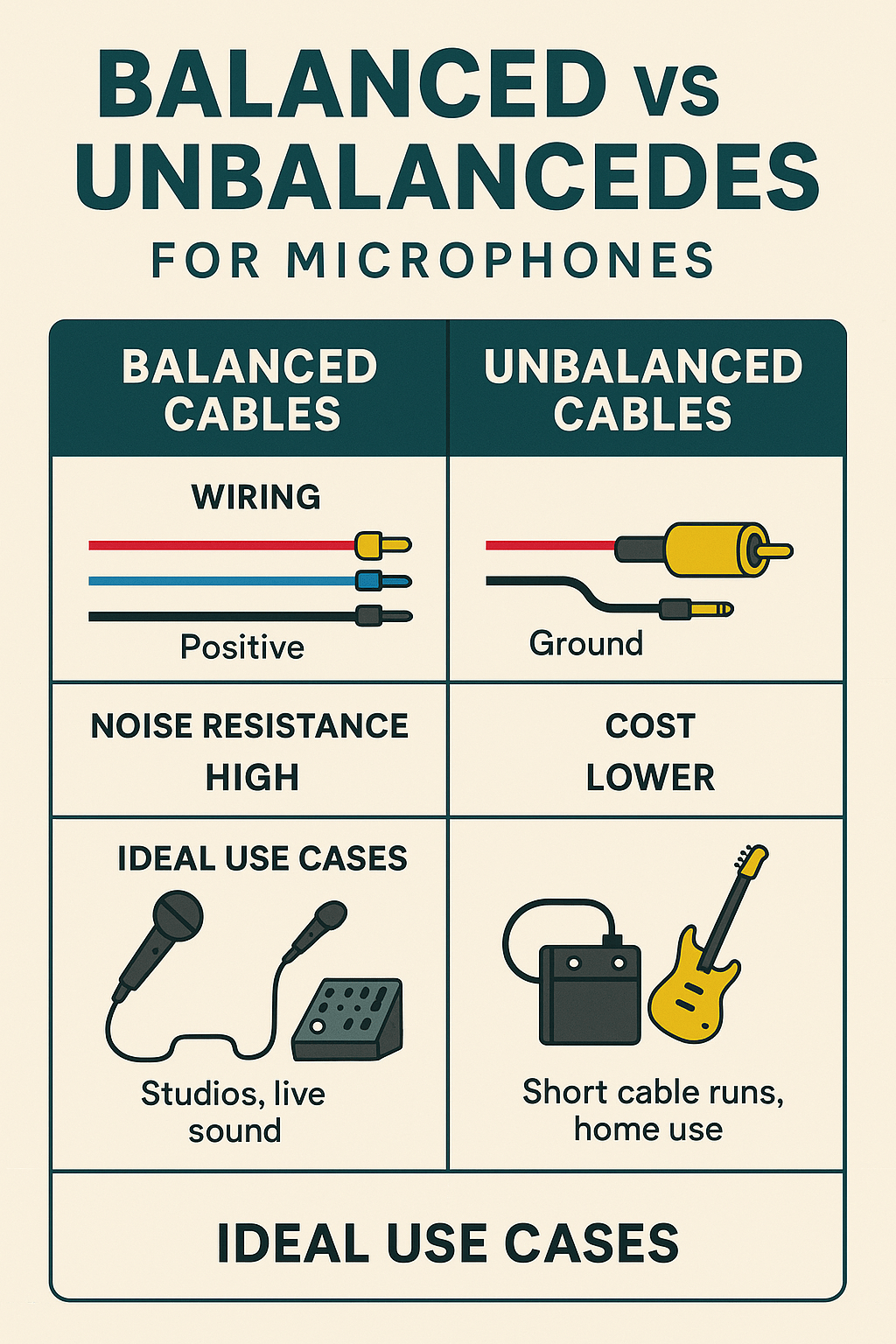When you’re setting up a microphone—whether it’s for recording vocals, podcasting, or streaming—it’s easy to focus on the mic itself and forget about the cables. But here’s the thing: the cable you use does matter. Understanding the difference between balanced and unbalanced cables can save you from annoying hums, signal loss, and audio headaches.
Let’s break it down together so you can make smart choices for your setup.
What Are Balanced and Unbalanced Cables?
First things first—what do we mean by balanced and unbalanced?
- Balanced cables are designed to carry audio signals with extra protection against noise and interference.
- Unbalanced cables are simpler and more common in consumer gear but are more vulnerable to picking up unwanted noise.
In the world of audio engineering, choosing the right cable helps keep your recordings clean and your setup reliable.
Balanced Cables
So how do balanced cables actually work?
The Technical Stuff (Made Simple)
A balanced cable uses three wires inside:
- A positive signal wire
- A negative signal wire (which carries the same signal but flipped)
- A ground wire
When your audio travels down the cable, any noise picked up along the way gets canceled out when the two signal wires are combined at the other end. It’s a clever trick that audio gear uses to keep your signal clean.
Why Use Balanced Cables?
Here’s what makes them awesome:
- Noise rejection – They’re great at blocking out interference from things like power cables, lights, and other gear.
- Signal integrity – You can run them over long distances without losing sound quality.
- Perfect for studios and stage – Balanced cables are ideal in professional settings where clean audio is critical.
Common Examples:
- XLR cables (used with most microphones)
- TRS cables (the ones that look like a standard headphone jack but with an extra ring)
Unbalanced Cables
Alright, now let’s talk about unbalanced cables.
The Technical Bits
Unbalanced cables only use two wires:
- A signal wire
- A ground wire
That ground wire also acts as a shield, but it’s not as effective. If the cable is too long or crosses power lines, it can pick up hums and buzzes.
What Makes Them Useful?
Don’t count them out—they still have their place.
- Simple and cheap – Fewer parts mean a lower price tag and easier to find.
- Great for short runs – If your mic is close to your recorder or mixer, you might not need anything fancy.
- Common in home setups – Many entry-level mics and instruments use unbalanced cables.
Common Examples:
- TS cables (like those used for guitars)
- RCA cables (think red and white audio plugs)
Balanced vs Unbalanced: Head-to-Head
Let’s compare them side-by-side:
| Feature | Balanced Cables | Unbalanced Cables |
|---|---|---|
| Signal Quality | Cleaner over long distances | Good for short runs |
| Noise Resistance | Excellent | Poor |
| Cost | Usually higher | More affordable |
| Use Cases | Studios, live sound, pro setups | Home use, short cable runs |
If you’re serious about getting clean recordings or working in a noisy environment (like a stage or studio), go balanced. If you’re just connecting a mic a few feet away in your home office, unbalanced might be totally fine.

When Should You Use Each Type?
Go Balanced If:
- You’re using XLR mics
- Your cables run longer than 15-20 feet
- You’re recording in a studio, live venue, or near a lot of electronic gear
Use Unbalanced If:
- You’re doing simple home recordings
- Cable runs are short (under 10 feet)
- You’re on a tight budget and not getting noise problems
Best Practices:
- Don’t mix and match: Using a balanced cable with unbalanced gear won’t magically give you balanced performance.
- Keep unbalanced cables short: The shorter, the better to avoid signal degradation.
- Use quality cables: Cheap cables = more problems, no matter the type.
Wrapping It Up
To sum it all up:
- Balanced cables are the go-to for clean, noise-free audio, especially in pro settings.
- Unbalanced cables are simpler and cheaper, but best kept short and noise-free.
In the end, choosing the right cable might seem like a small detail, but it can make a big difference in your sound quality. So next time you’re hooking up your mic, take a second to check your cable—and pick the one that matches your setup.
Your ears will thank you.
Want help picking the right cables for your gear? Drop a comment or check out our roundup of the best XLR and TRS cables for beginners!

Leave a Reply